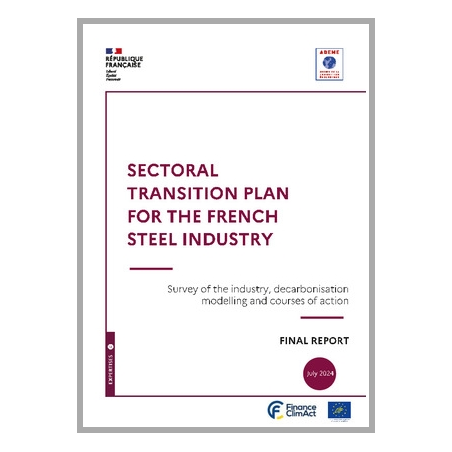Plan de Transition Sectoriel de l'industrie de l'acier en France - rapport complet
Etude/Recherche
Mis en ligne le : 26/07/2024

Survey of the industry, decarbonisation modelling and courses of actions - Finance Climact
French steel production amounts to 15 million tonnes a year, and is responsible for 5% of French greenhouse gas emissions. Today, there are two routes for the production of steel: the blast furnace sector, which produces primary steel and is responsible for 85% of the industry’s emissions, and the electrical sector, which supplies recycled steel by the conversion of scrap in electric arc furnaces. This route is the most effective means of decarbonising the steel industry, but it is hampered by the limited availability of high-quality scrap. Two other alternative technologies are also in the course of development for the production of steel without coal: direct reduction and direct iron electrolysis. While the effectiveness of hydrogen-based direct reduction has been tried and tested on a pilot scale, iron electrolysis is still in the course of development. In both cases, large-scale deployment will require favourable conditions, in particular a high price of CO2 and a substantial, competitive supply of decarbonised electricity.
ADEME has thus elaborated three contrasting scenarios in order to illustrate the challenges of far-reaching decarbonisation of the steel industry, making it possible to achieve the targets set by the French National Low-Carbon Strategy of an -81% reduction in CO2 emissions by 2050 as compared with 2015.
French steel production amounts to 15 million tonnes a year, and is responsible for 5% of French greenhouse gas emissions. Today, there are two routes for the production of steel: the blast furnace sector, which produces primary steel and is responsible for 85% of the industry’s emissions, and the electrical sector, which supplies recycled steel by the conversion of scrap in electric arc furnaces. This route is the most effective means of decarbonising the steel industry, but it is hampered by the limited availability of high-quality scrap. Two other alternative technologies are also in the course of development for the production of steel without coal: direct reduction and direct iron electrolysis. While the effectiveness of hydrogen-based direct reduction has been tried and tested on a pilot scale, iron electrolysis is still in the course of development. In both cases, large-scale deployment will require favourable conditions, in particular a high price of CO2 and a substantial, competitive supply of decarbonised electricity.
ADEME has thus elaborated three contrasting scenarios in order to illustrate the challenges of far-reaching decarbonisation of the steel industry, making it possible to achieve the targets set by the French National Low-Carbon Strategy of an -81% reduction in CO2 emissions by 2050 as compared with 2015.
Documents associés
Etude/Recherche
Mis en ligne le : 26/07/2024